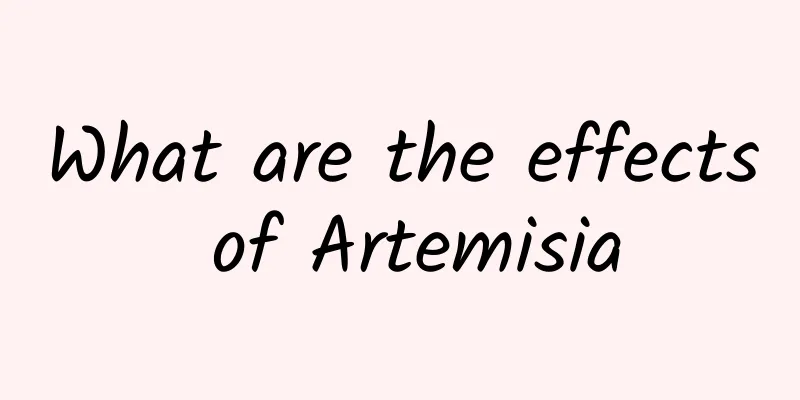What are the effects of Artemisia

|
Due to geographical reasons, I have never seen what Artemisia white artemisia looks like. At this time, I can only rely on Baidu to help me find Artemisia annua. Personally, I feel that the Artemisia annua on Baidu Pictures is not as good-looking as ginseng. The only thing I like is the color of Artemisia annua, a color that cannot be described in words. At first glance, Artemisia annua looks a bit like red rock sugar, crystal clear. 【Nature and flavor】: bitter; slightly sweet; cool in nature [Source of medicinal materials]: The whole herb of Artemisia macrophylla of the Asteraceae family. [Pharmacological action]: The sesquiterpene γ-lactone isolated from it has an inhibitory effect on Staphylococcus aureus, Escherichia coli, etc. in vitro. [Usage and Dosage]: For oral use: decoct in water, 10-15g, double the amount for fresh product; or mash into juice; or grind into powder. Artemisia grandis is an annual or biennial herb, 50-150cm tall. The taproot is single and narrowly fusiform. The lower part of the stem is slightly woody, with obvious longitudinal ridges and many branches. The stem and branches are covered with white fine hairs. Leaves are alternate; petiole is 1-4cm long; lower and middle leaves are white wormwood Broadly ovate or broadly ovate, 4-8cm long, 3-6cm wide, two to three times pinnate-cleft, with 2-3 lobes on each side, the lobes often become irregular pinnate-cleft or deeply lobed, the lobes are linear or linear-lanceolate, 2-10mm long, 1-2mm wide, with obtuse or acuminate tips. There are small pinnate-divided pseudostipules at the base; the upper leaves and bracts are pinnately divided or split, elliptic-lanceolate or lanceolate, and sessile. Inflorescence capitula, numerous, hemispherical or nearly spherical, 3-6mm in diameter, with short stalks, often with linear bracts at the base, arranged in racemes or compound racemes on branches, with 3-4 layers of involucres, the outer and middle layers with grayish white fine hairs on the back or nearly glabrous, the midrib green, the margin narrowly membranous, the inner layer membranous. Inflorescence receptacle hemispherical, with white pubescence; male flowers 2 (-3) layers, 20-30 flowers, corolla brimming with 2-4 lobes, style linear, apex bifurcated; bisexual flowers multi-layer, 80-120 flowers, corolla tubular, anther upper appendage pointed, long triangular, base with short pointed tip, style equal to corolla, apex forked, fork end truncated, with eyelashes. Achenes oblong. Flowering and fruiting period is from June to October. After understanding the medicinal value of Artemisia annua, I believe everyone has begun to utilize the medicinal value of Artemisia annua accordingly. Friends who have symptoms similar to those described above can use Artemisia annua for treatment, which may be very effective. Because I have never used Artemisia annua, I don't know how effective it is. Let’s just use the word “maybe” to describe it here. |
<<: What are the common Chinese medicinal herbs for health preservation?
>>: Where is the medicinal value of Artemisia argyi reflected?
Recommend
World Health Day: Can’t give up the taste? “Sodium” is not a good idea! If you like strong flavors, you should reduce the amount of salt!
What are the difficulties in reducing salt intake...
The efficacy and function of bean sprouts
The Chinese medicine buds are a very good Chinese...
Cold air is coming! People who are afraid of cold should cover these 4 parts of their body
According to Jiangsu Meteorological Bureau The hi...
There is a 71% probability that "La Niña" will return. Is another unprecedentedly cold winter waiting for us?
What? Another extreme weather event is coming?! 2...
Can those inconspicuous little holes on the eggshell actually cause big bugs on the dining table?
As the saying goes, flies don't bite seamless...
The efficacy and function of rock vegetable
The medical value of rock lettuce is beyond our i...
Why do I need to be on an empty stomach for blood draw? Does drinking water count as being on an empty stomach? I finally figured it out today.
For hospitalization, blood draws are usually done...
[Popular Science of Chinese Military Technology] Why are helicopter engines so different from those of fixed-wing aircraft?
As we all know, the power of aircraft flight come...
The efficacy and function of the umbrella tree
We know that there are many kinds of Chinese medi...
What are the benefits of corn bee pollen
Many people use corn and bee pollen to make the s...
The efficacy and function of hydrangea parsnip
Speaking of hydrangea and parsnips, many people k...
Diagnostic criteria for infectious diarrhea
Diarrhea is a common disease in daily life. Eatin...
Science Museum丨How many alarm clocks are best for waking up?
The holidays are over and summer is quietly appro...
What! We won't be able to drink Coke in half a year?
On a hot summer day, opening a bottle of ice-cold...









